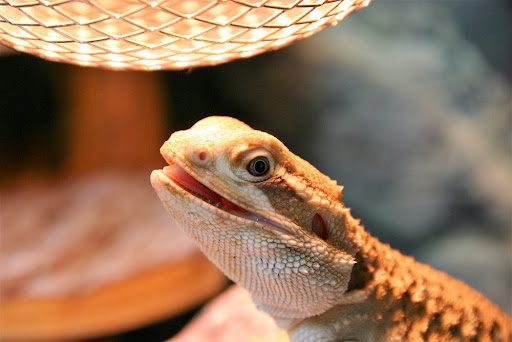Providing the proper heating for your reptile is extremely important for their health and wellbeing. Reptiles are ectothermic, meaning they rely on external heat sources to regulate their body temperature. Without adequate heating, reptiles can experience health issues like respiratory infections, poor digestion and inactive behavior. In this article we talk about Choosing the Best 2024 Reptile Heating Options.
When setting up a reptile habitat, the heating elements are key components that enable your reptile friend to thrive. This article will go over the critical considerations for selecting heating products and constructing a thermal gradient to meet your pet’s needs.
Table of Contents
Assessing Your Reptile’s Heating Needs
There are a few key factors that determine the type and amount of heat your reptile requires:
Species
Certain species have higher or lower optimal temperature ranges. For example, bearded dragons do well with basking spots of 95-110°F while leopard geckos only require 88-92°F. Always research the specific needs of your reptile’s species.
Age
Hatchlings and juveniles generally require slightly warmer temperatures than adult reptiles. This helps support healthy growth and development.
Size of Enclosure
The larger the tank, the more heating power you need to sufficiently warm the space. Consider the dimensions when choosing heating elements.
Ambient Room Temperature
If your home or reptile room tends to be cool, more intense heating solutions may be necessary for the enclosure.
By understanding these specifics, you can better provide a comfortable, safe thermal habitat suited to your reptile.
Types of Reptile Heating Elements
There are several different heating options to choose from when constructing your reptile’s environment. Which products you select will depend on your reptile’s needs, enclosure size, and setup.
Incandescent / Halogen Bulbs
Incandescent and halogen bulbs produce light and heat from an internal tungsten filament. They can be used to create concentrated hot spots and lighting for basking. Pros include adjustable brightness/heating power and low cost. Cons are higher electricity usage and short lifespan.
Ceramic Heat Emitters
Ceramic heat emitters (CHE) generate heat from an enclosed ceramic element but do not emit light. This makes them ideal 24/7 heat sources. Pros: emulate natural rock formations, long-lasting, energy efficient. Cons: heating limited to one area, no ambient light.
Heat Mats / Tape
Heat mats and undertank heaters provide warmth from underneath one section of the tank. They are designed for consistent, uniform heating day and night. Best for ground-dwelling species. Easy to install and regulate, but can only heat a limited area.
Basking Bulbs
Specialized basking spot lamps and bulbs create a hot focal point in one area of the habitat while allowing a temperature gradient. Different wattages cater to species with varying heat needs. Effective for encouraging activity but energy intensive.
Radiant Heat Panels
Radiant heat panels are flat panels that mount inside the enclosure to provide widespread ambient heat and warmer basking zones. Even, energy efficient heating, but requires proper mounting and reflects heat downward mostly.
Understanding these basic functions and benefits of the varieties of heating elements is useful when determining which option(s) suit your needs. Most enclosures incorporate multiple complementary heat sources to create ambient heat and targeted hot spots.
Setting Up a Thermal Gradient
Maintaining a proper thermal gradient in your reptile habitat means providing a temperature range from the warmest basking area to the coolest hide. This gives your reptile options to self-regulate their body temperature by moving between zones.
The best practice is to establish:
- A hot basking zone at one end of the tank, heated to the ideal temperature for your species. This is where targeted overhead heating elements like basking lamps are utilized.
- An adequately warm ambient temperature throughout the majority of the enclosure. This can be created with undertank heating pads, ceramic heat emitters, or radiant heat panels.
- One or more cooler hides equipped with substrate and furnishings for burrowing or hiding. These provide reprieve from the heat when needed.
The key is facilitating a diversity of temperatures so your reptile can find its optimal comfort zone. Use a high quality thermometer with a probe to carefully monitor the gradient and adjust heating elements as necessary to maintain appropriate hot and cool ends.
Always refer to guides for your specific species’ ideal temperature range before setting up the heating. For example, a bearded dragon setup would have a basking area of 100°F, ambient air temp around 80°F, and cool end around 70°F.
Additional Heating Safety Tips
To further ensure your reptile’s heating setup is safe and healthy:
- Choose reptile-specific heating products and check that wattages are appropriate. Human heating devices can get too hot.
- Connect heat sources to a thermostat or rheostat to automatically regulate temperatures.
- Position heat lamps properly to avoid burns and do not allow contact with substrates.
- For undertank heating, always use heat-resistant pads made for reptile use and keep properly secured.
- Frequently check for hazards like cords, hot surfaces, or loose substrates.
Following these best practices along with the specific care guidelines for your reptile species will lead to getting your heating setup right. Provide multiple heat zones, maintain the ideal thermal gradient and utilize safe heating tools monitored by thermostats. This will allow your reptile to thrive in a comfortable, enriching habitat.
Choosing Heating Products for Specific Reptiles
The heating options for a leopard gecko will differ from that of a crested gecko based on their natural environments and temperature requirements. Here is a brief overview of considerations for some popular reptile pets:
Bearded Dragons
From the arid deserts of Australia, bearded dragons are diurnal lizard needing bright overhead basking lamps (100-110°F), undertank heating pads and ambient temperatures around 80°F.
Leopard Geckos
Nocturnal temperature drops are important for these geckos native to the rocky grasslands of Asia. Use undertank heating mats (88-92°F) and low wattage incandescent bulb to maintain a hot side and cooler night temperatures.
Crested Geckos
Tropical rainforest environments mean these geckos do best with more limited heating focused mainly on keeping ambient room temps between 70-80°F. Low wattage incandescent or ceramic heat emitters prevent overheating.
Blue-Tongued Skinks
Give these vivacious lizards from Australia and Asia a thermal gradient using basking spot lamps, ceramic heat emitters and heat mats to allow for their movement between 70-90°F.
Always tailor heating methods to what most closely mimics the native environment of whichever reptile species you care for. Catering setups to their wild habitat needs leads to greater health and activity.
Popular Heating Products in 2024
Zoo Med Repti Basking Spot Lamp
Widely recommended for its focused beam that creates an optimal basking spot. Available in various wattages to suit different enclosure sizes
Exo Terra Heat-Glo Infrared Spot Lamp
Ideal for nocturnal heating, this infrared lamp provides consistent heat without visible light, making it perfect for night-time use.
Fluker’s Ceramic Heat Emitter
Known for its durability and efficiency, this ceramic heater is excellent for maintaining consistent temperatures without light emission.
Zoo Med Reptitherm Under Tank Heater
A reliable choice for providing belly heat, especially for snake and gecko enclosures. Ensure it is used with appropriate ventilation and safety measures.
Arcadia D3 UV Basking Lamp
Combines heat and UVB radiation, making it a comprehensive solution for reptiles requiring both. Its efficiency and long lifespan justify the higher cost
Final Thought
Providing proper heating for your treasured reptile involves understanding species requirements, implementing suitable heating tools, regulating with thermostats and monitoring temperature gradients. Pay close attention to your pet’s behavior within their habitat and note any changes to determine if heating adjustments need to be made. I sincerely hope you find this “Choosing the Best 2024 Reptile Heating Options-What You Need to Know” article helpful.

Maykon Alvarenga is a seasoned pet care expert with over 8 years of experience in the field. He holds a Master’s degree in Veterinary Science, specializing in small animal care. His passion for pets is reflected in his work on PetsBent.com, where he shares valuable insights on pet health, behavior, and training. Maykon is dedicated to helping pet owners provide the best care for their furry friends. Connect with him on Instagram at @maykon.alvarenga for more tips and updates.

